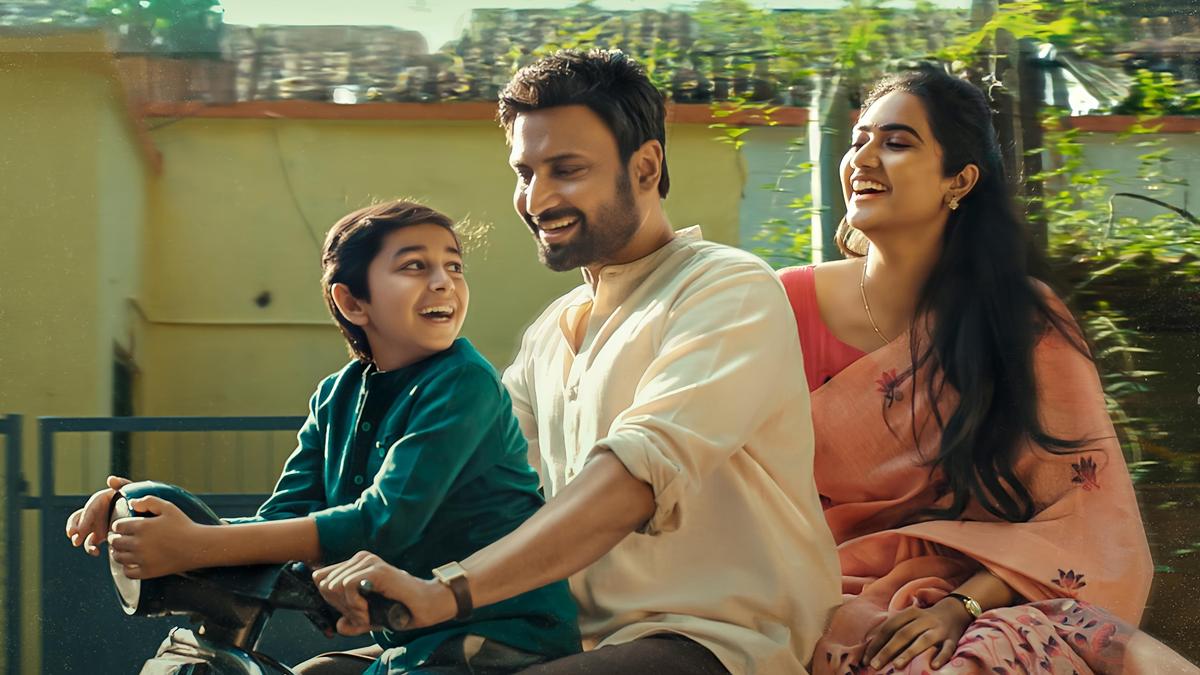Child actor Viharsh, Sumanth and Kajal Choudhary in the film
| Photo Credit: Special Arrangement
Last year, the Telugu film 35: Chinna Katha Kaaduasked viewers to consider why zero — seemingly without value — becomes greater than nine when placed after a one. The message was a subtle but effective way of empowering students struggling with mathematical concepts. This year, director Sunny Sanjay returns with Anaganaga, streaming on ETV Win, which presents science lessons — ranging from eclipses to the role of red and white blood cells — through short, story-driven episodes.
At the heart of the film is Vyas Kumar, a storyteller-teacher played with quiet sincerity by Sumanth, in one of his most nuanced roles. He brings learning to life for children who find traditional methods difficult to absorb.
Loosely adapted from the Marathi film Eka Kay Zaala, Anaganaga opts for simplicity, using its narrative as a gentle teaching tool. Like Taare Zameen Parand 35, it follows a familiar underdog arc, delivering its message with warmth and clarity without talking down to its audience.
Anaganaga (Telugu)
Director: Sunny Sanjay
Cast: Sumanth Kumar, Kajal Choudhary
Run time: 136 minutes
Storyline: A school teacher who believes in the power of storytelling must make his students pass the examinations. But there are further hurdles.
Streaming on: ETV Win
In the early portions of Anaganaga, Vyas (Sumanth) enters a rigid, high-pressure international school with a wide smile, immediately clashing with the school chairman’s (Srinivas Avasarala) strict guidelines. From that moment, the story’s arc feels predictable, yet it wins the viewer over by reinforcing the value of storytelling as a learning tool, offering an alternative to rote education.
Vyas’s home life runs parallel to his teaching journey. His wife, Bhagya (Kajal Choudhary), is the school principal, and their son Ram (Viharsh) is one of the many students struggling to keep up. While Vyas is warm and easygoing, Bhagya shoulders the strain of being the family’s primary provider, and her stress frequently seeps into their personal life. Tensions between the couple play out thoughtfully, often in front of a mirror, visually reinforcing their differing worldviews and emotional states.

Vyas may be dismissed as a “failed story,” but Anaganaga is not just about one teacher proving his method works. It quietly explores deeper questions: Do parents or teachers ever stop to ask what truly intimidates a child? What if a student who struggles is not met with judgement but with reassurance that failure isn’t the end of the road?
The film takes a hard look at the darker side of academic competition — rewarding toppers with podium finishes while publicly singling out those who fail, even resorting to corporal punishment. It advocates for empathy in education and questions what is lost when sports and personality development are edged out by the tyranny of marks. It reminds us of those moments when a dreaded science period replaced a beloved language class, and that familiarity gives the film its quiet power.

In its final stretch, Anaganaga treads familiar ground with a health-related subplot that risks feeling clichéd. But to its credit, the narrative uses this moment with care — to reflect on an earlier question posed to Vyas: what will he leave behind for his son? The answer, layered into the film’s philosophy, is not material, but emotional legacy.
Anu Hasan’s warm cameo offers a key perspective, gently peeling back the layers of Vyas’s own formative influences. Even the storyteller, it seems, needs his own story to hold on to. Her brief role helps underline the film’s central idea that strength sometimes comes from looking inward, from rediscovering the will to move forward.
Visually, nothing feels overdone. Pavan Pappula’s cinematography, Chandu Ravi’s gentle score, and the unobtrusive production design keep the film grounded. A few characters may lack dimension — like the overbearing school chairman — but the film does not stumble because of them.
Anaganaga may follow a familiar arc, but it makes its point with grace. It celebrates storytelling not just as a teaching tool but as a way of healing, connecting, and remembering what really matters.
Published – May 15, 2025 04:16 pm IST
